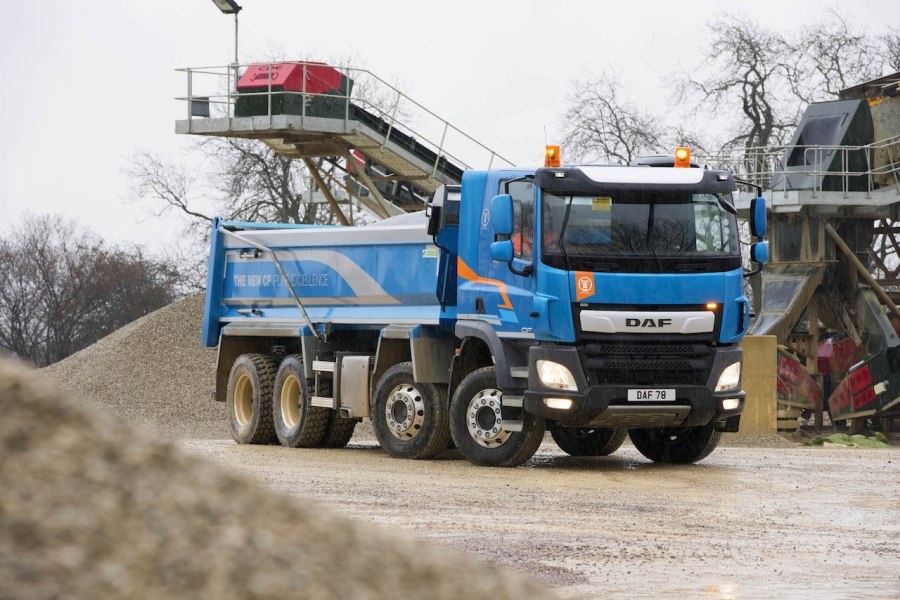In the alt-fuel race, DAF is backing Hydrotreated Vegetable Oils (HVO) as a clean, easy and efficient diesel substitute. We took two new DAF CF FAD 8×4 (HVO) tippers into a quarry to find out how its performance stacks up.
As pressure mounts on operators to make the switch from ‘dirty’ diesel, you’d be forgiven for thinking a substantial investment in new kit is required to run on an alternative fuel. While this is certainly true for hauliers considering trucks running on gas (CNG or LNG) or electricity, it’s not in fact a prerequisite to ‘green’ operation.
Perhaps the easiest switch to make is from diesel to Hydrotreated Vegetable Oils (HVO). Produced using a range of waste products from the food processing industry (cooking oils, animal fats and other waste fats) or specially harvested crops such as palm and rapeseed oil, HVO offers a raft of environmentally sound benefits – headlined by a whopping 90 per cent reduction in carbon emissions.
Easy switch?
Another major benefit is HVO requires no special kit on the vehicle. This is a 100 per cent ‘drop in’ fuel, and its usage has been approved by Dutch manufacturer DAF in all its Euro 3, 4 and 5 engines without any restrictions, plus its PX-5, PX-7, MX-11 and MX-13 Euro 6 powerplants. Other manufacturers have also given it the thumbs-up.
And there are other plus points. “HVO has air quality benefits as it produces almost no sulphur or aromatics,” DAF’s marketing manager, Phil Moon, tells us. (We put this to the test – once a new CF FAD demonstrator had been filled with HVO, we took a quick sniff of the nozzle and can confirm the fuel is virtually odourless.)
“It’s also easy to distribute, as it doesn’t require any special pipes or tanks,” Moon continued. “It’s compatible with all engines and requires no special maintenance – in fact, maintenance intervals are the same as for trucks running on diesel, and warranties aren’t affected either.”
So far, so good. However, running with HVO is not without its disadvantages. Firstly, and perhaps most alarmingly, HVO carries a considerable price premium over regular diesel to the tune of around 25-30 per cent (though there are rumblings the UK government may review the amount of duty in the future).
Alongside this, HVO carries a lower calorific value: the energy value of EN15940 HVO is 34.3 MJ per litre, compared to 35.8 MJ per litre for regular EN590 diesel. Fuel consumption of trucks running 100 per cent on HVO is theoretically four per cent higher than diesel, though additives are being used to mitigate the effect.
Its also worth pointing out there is no current production of HVO in the UK, though there is growing capacity in Europe. The majority of HVO sourced for Britain comes from Rotterdam, the Netherlands; Porvoo, Finland; Venice, Italy and Marseille, France.
On the road
But how does the fuel fair in terms of performance? We hadn’t had the opportunity to drive a vehicle running purely on HVO, so when DAF offered us a drive in two new CF FAD 8×4 tipper demonstrators, we were interested so see how they faired.
We met the vehicles on a sunny March morning at one of DAF’s service points on the outskirts of Kidlington. The first one we took out was a CF410 FAD with Wilcolite aggregate tipping body running at 32 tonnes with a load of gravel. It was also spec’d with a Day Cab, and the 420 bhp MX-11 engine was mated to DAF’s new TraXon 12-speed automated gearbox.
Once settled in the cab (which featured an extra-comfy Super Air driver’s seat), we eased out of the industrial estate and headed for the Gill Mill quarry just off the A40 in Ducklington. Traffic was moderate and we encountered a large tailback caused by a limping double-decker bus, but the smooth-shifting TraXon made our stop-start progress effortless.
Having driven a few gas-powered trucks recently, we were particularly interested to see if HVO produced any noticeable dips in performance. Both ourselves and Dougie have remarked on the LNG-powered Stralis NP’s slightly laggy characteristics at pull-away, but we noticed none of this with the HVO CF. In fact, we’re sure drivers will soon completely forget the truck is not running on diesel – in terms of grunt and general get-up-and-go, there’s hardly anything in it.
Turning off the main road and onto the quarry site, the CF dug in and we were off for a play in the sand. Our time on site was limited, but we managed to do a fair few laps around the mounds of collected stones, weaving in and out of the stone piles and across varying surfaces. Recent rainfall had made the going wet and soft in places, but the truck soldiered through with no problems at all.
At the far end of the site, we were challenged to climb the CF up a particularly large loose gravel deposit to see if we could reach the top. On our first go, we managed to get about three-quarters up the slope before the tyres spun, but our second attempt faired better. This time we dabbed the button on the right-hand stalk to switch to manual and held onto fourth, and we sailed up with no problems.
Not at all bad for the 410 lump – and further proof that for most operations, modern automated ’boxes are more than adequate for running off-road (though some manual intervention may be required).
Hands on
Once we’d run the truck through the wheel wash and returned to base, we hopped straight into the waiting CF450 FAD. Running at the same weight, this truck was fitted with a Taperlite single-skin steel tipper body and its 450 bhp MX-11 was running through a ZF 16-speed manual gearbox with range-change and splitter.
The traffic had eased off a bit for our second trip to the quarry. Though it’d been a while since we’d driven a manual, working the transmission soon became second nature.
Back at the quarry, the manual ’box proved its worth as we navigated the soft ground and once again faced the climb up the stone pile. This time we nailed it first time, with the extra grunt of the 450 bhp engine pulling us up in fourth gear with no problem at all.
Verdict
HVO makes a very strong case as an alternative to diesel in terms of operation. We couldn’t point our finger at any noticeable signs that we were running on HVO during our two test drives, and the fact it can be dropped into the tank of regular diesel trucks (either as a complete replacement or mixed in) without the need for extra kit is a major boon. Factor in a potential 90 per cent drop in CO2 emissions and easy filling and storage, and the fuel almost seems like a no-brainer.
But then there’s the price. With HVO costing in the region of 25-30 per cent more than diesel, operators would need to have a strong ‘green’ requirement for using it – perhaps to satisfy strict internal policies of carbon reduction, or to keep some eco-friendly customers happy. But even with these considerations, such a mark-up at the pump will be very hard to swallow. It’s going to take a serious slashing of fuel duty from the government to make HVO a truly cost-effective and viable diesel substitute.
More information: http://www.daf.co.uk








